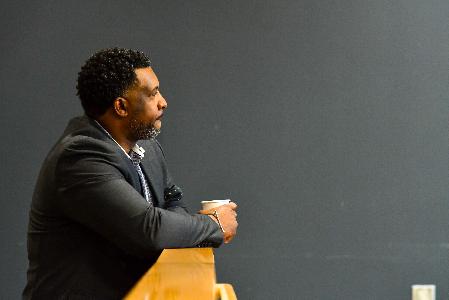Knowing when to apply the methodology and approach of design thinking is essential.
Walking into an organization and requesting weeks and months to engage in design thinking can raise concerns as companies are moving fast, clients want things now and spending time under an internal assessment requires commitment and buy-in from leadership.
Therefore, if you want to use this technique — defined simply, if only partially, as a discipline that takes designer-informed, iterative approaches to problem-solving — assess the company culture and business strategy against its openness to collaboration-based design. The readiness will decrease the demand for quick answers.
Here are some other points leaders should keep in mind when thinking about implementing design thinking processes at their workplaces:
Leaders are designers
C-suite executives house the vision for the framework and lead multiple directions for the organization. Design thinking can tackle a range of goals for that executive, probe and pose reflective questions and solve problems for the business model. Consider these questions:
- As marketers and business partners, how can we better tell the story of creativity and growth — and balance it with automation and performance?
- The big idea is great, but what about the business result?
- How can we define, identify, develop and ensure real, sustainable business growth?
Define the problem and foster ideas
Taking the time to frame the problem is what Apple, Google, and GE Healthcare share with Netflix and Capital One. The opportunity lies in asking instead of talking internally about what you think is needed. Instead, push toward a concise statement, so you genuinely solve the problem.

Karen R. Baker. (Courtesy photo)
Companies and organizations have complex internal problems they need to solve. Whether you are addressing the value proposition, business growth, customer retention, recruitment, supply chain distribution or pricing, design thinking can manage it. Company teams can transform how consumers experience a product or service through design thinking, leading to more customers, revenue, meaningful work and new ideas for innovation.
Got empathy? Listen up!
We constantly see the five phases of design thinking in any Google search: empathize, define, ideate, prototype, and test. However, empathy is a phase we do not talk about enough.
We’re all distracted throughout the day, from constantly checking our phone notifications to keeping 20 tabs open on our web browsers. But if you cannot pause and actively listen to the needs of the company, users and customers for whom you are solving a problem, you cannot empathize. When empathy is at the forefront of business design or the user experience, we can focus on understanding how we solve the problem with less bias. You quickly answer questions about thinking and feeling; their role in the situation, space and environment; and their fears, frustrations and anxiety. Active listening builds trust and relationships within the design process, thus preventing you from missing what they need and value.
Lastly, it allows you to hear if problems exist. Otherwise, you can uncover the wrong answer and miss the opportunity to innovate.
Design thinking in action
Early adopters of design thinking include global brands like the aforementioned Netflix and Capital One. Both companies used the method and process for business model revisions, narrative transformation, content strategy and evolving their customers’ user experience. Netflix adapted design thinking into its business model, ultimately using it to pivot to on-demand streaming, decrease DVD rental and introduce original content with trailers. Capital One assembled a team of design practitioners to expand its banking services’ consumer experience. Now, did you know design thinking could deliver all of that?
In 2020, global giant Cisco also went through design thinking workshops and created frameworks, a design leadership team and a playbook with over 70,000 Cisco employees. The outcome was a program that, per its own description, “offered Cisco employees, partners, and clients a new set of tools and processes to work better together.”
Outmoded business models
In this new future of Web3 and the metaverse, companies wonder how their business model will stand through another innovation. Are they able to compete against the faceless, nameless company yet to surface, or do they stand the test of time? Either way, evaluating the model is one of the designing thinking processes that can offer a company a facelift or tweak. Tools like the “Business Model Canvas” take you through nine building blocks that deliver a visual canvas of the business.
The most fascinating part is there isn’t just one canvas for a business, particularly with multiple services, customer/client segments, and revenue streams — there could be five. However, the key isn’t a leadership-lead effort, but a way to engage the company to deliver better value.
Before you go...
Please consider supporting Technical.ly to keep our independent journalism strong. Unlike most business-focused media outlets, we don’t have a paywall. Instead, we count on your personal and organizational support.
3 ways to support our work:- Contribute to the Journalism Fund. Charitable giving ensures our information remains free and accessible for residents to discover workforce programs and entrepreneurship pathways. This includes philanthropic grants and individual tax-deductible donations from readers like you.
- Use our Preferred Partners. Our directory of vetted providers offers high-quality recommendations for services our readers need, and each referral supports our journalism.
- Use our services. If you need entrepreneurs and tech leaders to buy your services, are seeking technologists to hire or want more professionals to know about your ecosystem, Technical.ly has the biggest and most engaged audience in the mid-Atlantic. We help companies tell their stories and answer big questions to meet and serve our community.
Join our growing Slack community
Join 5,000 tech professionals and entrepreneurs in our community Slack today!

Do zero-waste takeout containers work? We tried a new DC service to find out

Top tech stories of 2024: How AI, cyber and community made DC innovation sing

This Week in Jobs: Travel far in your career with these 26 open tech roles


